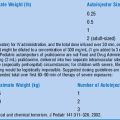Chapter 6 Altered Mental Status
2 What clues can I use to determine whether altered mental status is due to a toxic ingestion?
Dobson JV, Webb SA: Life-threatening pediatric poisonings. J S C Med Assoc 100:327–332, 2004.
5 What do the letters DPT, OPV, HIB, and MMR stand for?
| D = Dehydration | O = Occult trauma |
| P = Poisoning | P = Postictal or Postanoxia |
| T = Trauma | V = VP shunt problem |
| H = Hypoxia or Hyperthermia | M = Meningitis or encephalitis |
| I = Intussusception | M = Metabolic |
| B = Brain mass | R = Reye’s syndrome, other Rarities |

















